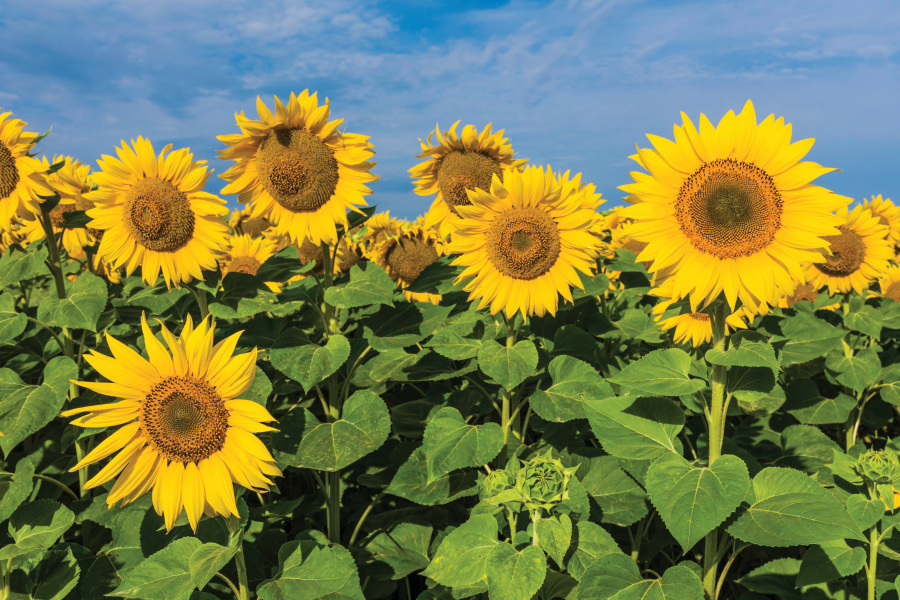How to Plant and Grow a Cut Flower Garden
Have you ever dreamed of filling your home with fresh-cut flowers but balked at the expense? Rather than spending money each week on bouquets, consider planting and growing your own cut flower garden this year for beautiful blooms all season long. In our guide below, we walk you through everything you need to know to get started.

Plan Your Garden
You can grow a shocking number of flowers in a small space. But you need to create a plan before you grab the shovel and get digging. Most flowers need a generous amount of sunshine and a space with rich and well-draining soil. A few may need trellises or other supports, but you can cross that bridge when you come to it.
Many gardeners grow flowers in raised beds so they can better control the soil quality, but you don’t have to call it quits if you don’t have the space or time to invest in raised beds of your own. You can tuck flowers between vegetables or shrubs, in pots and planters on the deck, or even at the base of select trees.
No matter where you decide to begin showing off your green thumb, stick to the first rule: plenty of sunshine and rich, well-draining soil.

Choose Flowers
Are you new to growing flowers? Flipping through a garden magazine or cracking open a cut flower garden book might make you want to go big or go home. But avoid the temptation to do too much in your first year and stick with a few tried-and-true favorites that will make it easier to succeed. Getting a few wins under your belt in year one will allow you to build on your momentum year after year – until one day you sit back and realize you’ve designed and cultivated the garden of your dreams.
From a practical perspective, plan to get a few tall, medium and small flower varieties that you can stagger (tallest in the back, mediums in the middle, and smallest front and center) during planting. Take note if any tall varieties need staking supports to help them stay upright as they grow. Depending on the aesthetic you’re after, you might also consider working with a single color palette (such as shades of pink) or a small variety of complementary colors and textures.
See more: 12 Flower Varieties to Plant This Spring

Get Planting
In the early days of spring, you could probably go to your local nursery or garden center and buy a few annual flowers to plant in the ground right away. Many grow rapidly and can be sown directly into the ground (or a container). But you can also start your garden using seeds, seed trays and grow lights.
First-timers would do best to work primarily with seedlings and starts from a local nursery. Do some research, either online or by calling up a few shops in your area, to see if anyone specializes in varieties that have been bred specifically for cut flowers. If you find some, try not to get sticker shock. You’re paying for flowers that were bred for desirable cut flower traits like a longer vase life, lengthier stems and bolder blooms.
Schedule an alert in your phone to succession plant as the season goes on. This means you will need to plant more than one round of flowers. Why? Succession planting will give you blooms all season long. As the first round of flowers dies off, the second round will blossom, and so on. Prepare to plant new seeds or starts every 2 to 3 weeks for a steady supply of fragrant flowers.
See more: How to Grow Sunflowers From Seeds

Garden Maintenance
As handy as it would be to plant your garden and wait for the flowers to be ready for cutting, there’s a little more maintenance required if you want your garden to thrive throughout the season.
Many flowers (like zinnias) will boast bigger and bolder blooms if you pinch their growing tips back when they’re still small (anywhere from 10 to 12 inches tall). Use a clean pair of pruning shears or garden scissors to remove the growing tip from each plant. Aim to cut back to the next set of healthy leaves.
Be mindful of your watering schedule. Check the moisture of the soil with your finger before giving your flowers another generous gulp of H2O. Some flowers will suffer stress if their soil is too wet or can’t drain properly and won’t produce their large, iconic blooms. This is especially important to keep at the forefront of your mind if you’re using landscape fabric or mulch.
Set an alarm on your phone to fertilize your flowers every two to three weeks with a liquid organic flower fertilizer. Many cut flower varieties are heavy feeders and will devour the nutrients in your soil before the end of the season unless you’re regularly offering them supplemental nutrition (in the form of fertilizer).
Each time you go outside to check on your flowers, do a quick scan for dying or dead blossoms. Removing these, otherwise known as deadheading, will encourage your plants to produce more – and bigger – blooms.

Harvesting
There are a few simple rules of thumb when it comes to harvesting the blooms from your cut flower garden. Following these basic guidelines will not only give you the best chance at growing better flowers but will also extend your flowers’ vase life.
- Harvest your flowers first thing in the morning or after the sun has set. You want to avoid harvesting in the peak heat of the day.
- Only cut flowers from plants that look healthy and not under stress (like those that may be suffering from overwatering).
- Keep a bucket of cool, clean water nearby while you harvest, and place the newly cut blooms in the water stem-side down right away.
- Use sharp and clean garden shears and cut each stem at a 45-degree angle to increase its surface area and water retention.
- Carefully strip your cut flower stems of any leaves or foliage that would otherwise sit below the water line in the vase. This will help prevent unwanted diseases that could contaminate the water and kill your flowers.
- Arrange your flowers indoors or in a shady area outside to avoid unnecessary wilting

Best Cut Flower Varieties
With more than 400,000 varieties of flowering plants to choose from, it could take you a lifetime to sort through each to find the best cut flower choices for your home garden. Instead of delaying your flower garden dreams, start by picking a few from our list of popular varieties:
Annuals
- Calendula (Calexis Orange)
- Bachelor’s Button (Florist Blue Boy)
- Dianthus (Sweet Black Cherry)
- Gladiolus (Princess Margaret Rose)
- Sweet Pea (Mollie Rilstone)
Perennials
- Long-stemmed Carnation (Chabaud La France)
- Sunflower (Frilly)
- Salvia (Bumblebee)
- Yarrow (Colorado Mix)
- Garden Phlox (Whipped Cream)
Bulbs
- Dahlia (Cornel Bronze)
- Calla Lily (Apricot Lady)
- Tulips (Angelique)
- Allium (Moly)
- Hyacinth (Delft Blue)
One Comment
Join the discussion and tell us your opinion.




Gorgeous and the season never needs to end. Try out these projects to make with dried flowers. https://www.charlottesvillefamily.com/5-projects-to-do-with-dried-flowers/